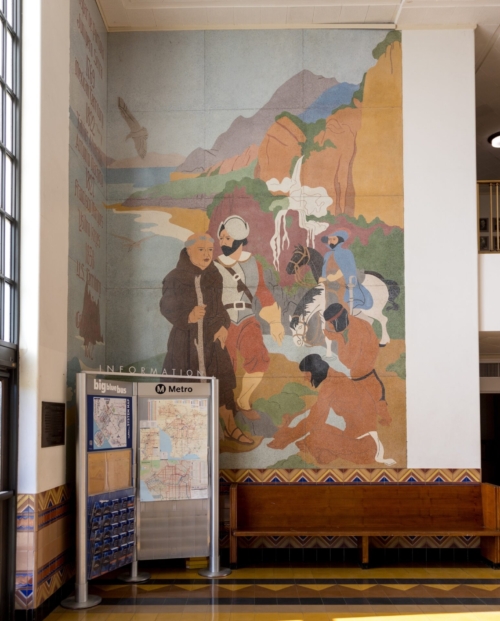News
Hiding History at City Hall’s Mural
by Ruthann Lehrer, Advocacy Committee Co-Chair
City Council voted 6-1 on May 11th to cover the historic mural in City Hall as part of its efforts to eradicate racial injustice in Santa Monica. The mural depicts Native Americans at a natural spring and the arrival of a Spanish monk and soldier in the 18th century. It was created by renowned artist Stanton MacDonald-Wright who was Director of the Southern California Works Progress Administration, a program initiated by President Franklin D. Roosevelt that provided federal grants for artists to create public art in public buildings for Depression-era economic recovery. Housed inside City Hall, a WPA project, the mural is part of a Santa Monica landmark.
As a history mural, there are indeed layered meanings, and implications about its subject. The mural shows two Native Americans kneeling by a natural spring, one drinking and the other with his hands in the water. The natural spring was the City’s first source of water, and still exists today in a nature preserve restored and tended by Tongva/Gabrieleno tribal members at University High School. Standing opposite the Native Americans are a Franciscan monk and a Spanish conquistador. Based upon Father Crespi’s diary of the Portola expedition of 1769, the scene represents the naming of Santa Monica.
The future subjugation of Native Americans may be implied by the positioning of the figures, and the mural evokes various phases of Santa Monica history, such as invasions of Spanish/Mexican conquerors and the Rancho period, when Native American lands were turned into large agricultural ranchos. California history has been rife with racial inequalities and social injustice, and the mural is a record of this difficult history.
The Arts Commission was poised to organize public forums to discuss the mural’s interpretation and how best to present it in its historical context while addressing racial injustice when the pandemic struck. The Commission is ready to do this again; however, with the shades pulled down and the mural obscured, it will be hard to have meaningful public engagement.
Rather than eliminate or cover the mural, what is needed are interpretative explanations alongside the City Hall artwork that place it in its historic context while engaging with issues of racial and social justice. The mural is an opportunity to educate our community about the original Native residents of the region, the founding of Santa Monica, the unfolding of California history in which Native Americans were decimated and how this history continues to impact our city and state. And so it’s not only important to preserve the mural, but to use it as an educational tool in a civic space. Additionally, the City should be proactive in using our public arts program to create new works that gives voice to our under-represented communities, like the Belmar History + Art project at 4th and Pico.
If we are to tell the whole stories of our communities, then we must preserve and educate rather than erase or hide our history.
This entry was posted in Advocacy City Hall Mural.
Bookmark the permalink.
